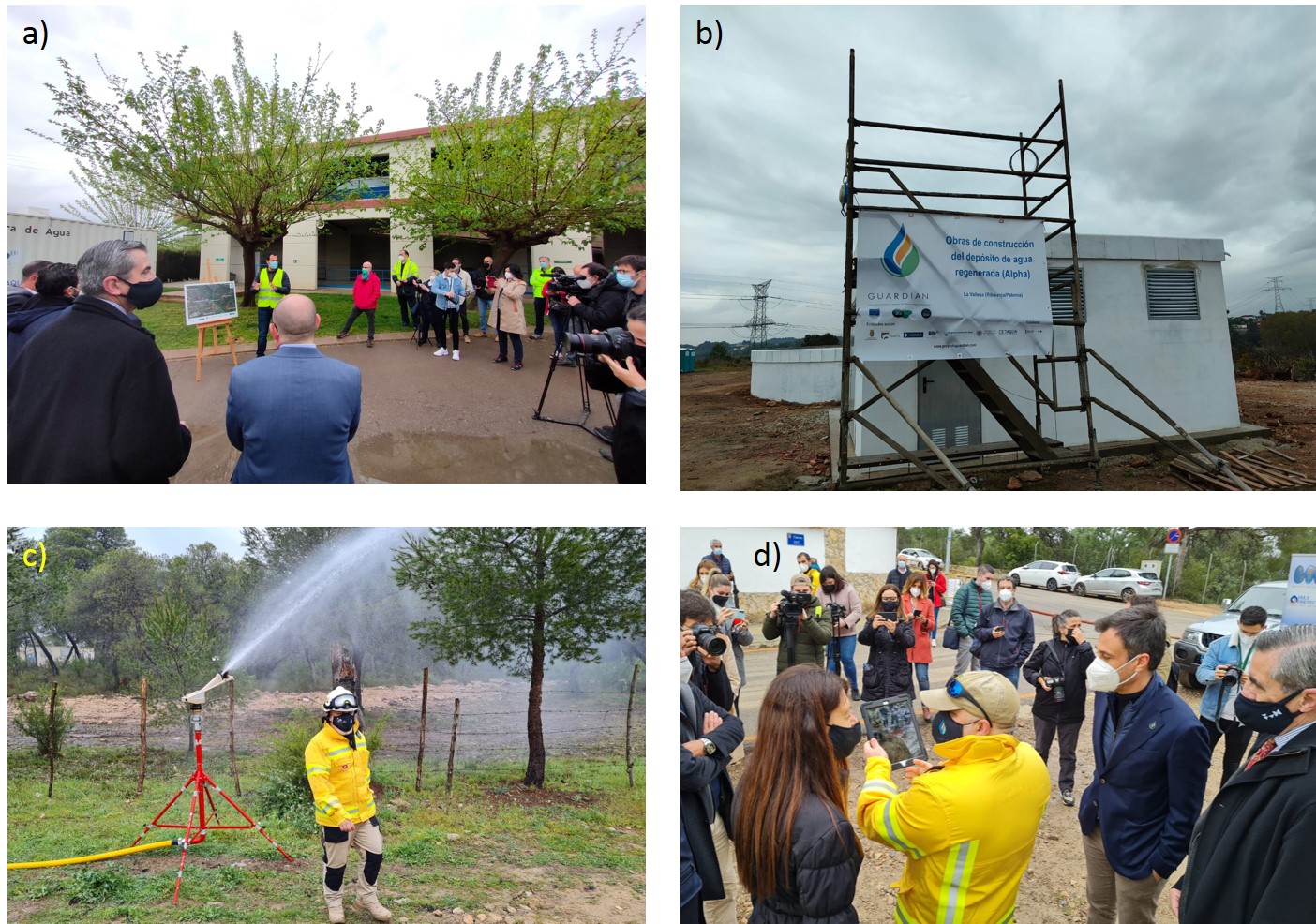
March 31st field tour: Technical visit to GUARDIAN works
On March 31st members of all GUARDIAN partners met promptly at 9:30h at the Waste Water Treatment Plant (WWTP) “Camp de Túria II” at Riba-Roja, for a field tour to the different sites in which GUARDIAN works are being carried out. After a whole year of virtual consortium assemblies, the meeting represented an extra-bonus of enthusiasm for us all, because, apart from having real evidence of the project progress we had the opportunity to greet us live (following all safety rules, of course!)
The first piece of infrastructure we saw already running was the Water Reclamation Plant (WRP- (check the first Zoom in for motivation and engineering details). Most of the water used in GUARDIAN will come from this WRP, considering a sustainable management model of the water cycle in the municipalities of Riba-Roja del Túria and Paterna applying circular economy concepts (web article 2). The WRP has been integrated in a High Cube container and installed in a corner of the WWTP facility (Figure1). The treatment capacity of the water regeneration station (ERA) is 10 m3/h and its planned continuous operation is an estimated annual regenerated water production of 80,000 m3/year. Nowadays, engineers from HIDRAQUA and CETAQUA are running the WRP under trial mode. Different operation conditions are being tested with the aim of optimizing the water reclamation process in terms of removals, energy consumption, operation cost and environmental impact.

From the WWTP we moved to the focal point of the water transportation network, the Alpha water tank. As mentioned in past Journal 2, the recycled water coming out of the WRP will be conveyed to the main tank (Alpha) and then pumped to secondary tanks located close to the WUI areas of “Cañada Norte”, “Cañada Sur” and “Els Pous”. Alpha will be also connected to “La Vallesa” pond, so that pumping recycled water will also contribute to increase ecosystem’s quality in the wetland.
Alpha has a capacity of 500 m3 and, as you can figure out from Figure 2, it is partially buried to minimize visual impact. The building work at Alpha site is well on its way, actually it is practically completed! The structure of both the tank and the adjacent control building for energy supply are now finished and ready to be painted. After that, pumping equipment will be placed inside the tank and a diesel-fueled generator (responsible to supply energy for pumps in case of fire) with all control elements will be accommodated inside the secondary structure (I hope I can show you some more images of this process soon!).

After visiting Alpha water tank works, we walked to “la Vallesa” pond, a beautiful natural area in the heart of the natural park (Figure 3). As an Integrated Fire Management (IFM) project (check Journal 1 to recall the concept), GUARDIAN also includes actions to increase environmental quality (and hence fire resilience!) in certain vulnerable areas of Túria NP. One of these areas is the wetland, for sure. The actions for the adaptation of this area consist basically on i) removing the excess of sludge (there is a 1-2 m deep layer that has to be taken out with dedicated machinery), ii) delivering regenerated water to increase the quality of the pond and iii) repairing and conditioning the entire environment to adapt it as a recreational area for visitors.

Our next stop was the experimental plot in which our colleagues from the UPV are quantifying the ecohydrological and energetic processes between the atmosphere, the trees and the soil in “la Vallesa” forests. We talked about this amazing piece of research in past web article 3, so I will not be giving further details on that in here. Just let me give you some more snapshots (Figure 4) to recall how remarkable this scientific task is. Once finished, it will clearly represent a significant advance with respect to the state of the art!

Next, we visited one of the WUI perimeter sections in which GUARDIAN is working to implement their green firebreaks, the “Cañada Norte” section, belonging to Paterna municipality (Figure 5). As you may already have noticed, the main pivot on which GUARDIAN strategy is deployed is the construction of green firebreaks, i.e. 50-60 m-wide strips located around the built perimeter containing fire-resistant vegetation which will be irrigated automatically with water cannons. This infrastructure is defined in GUARDIAN as a sustainable ecohydrological fire prevention solution in which forestry management is combined with artificial watering that in the case of “Cañada Norte” area will come from the Bravo water reservoir. The actions carried out in GUARDIAN for the implementation of green firewalls comprise classical forestry management strategies (i.e. thinning, clearing and pruning) combined with the introduction of species with high resilience to fire (e.g. species with high capacity to store moisture, with low fuel load, low levels of oils, etc.). In addition, there is a huge amount of landscape, hydraulic and civil engineering for the design, dimensioning and implementation of the water sprinkler network.

And we finished our tour to visit a field site (still in Paterna municipality) in which forestry management operations are being carried out to reduce wildfire risk, as part of this global IFM strategy (Figure 6). By thinning young Pinus halepensis pines regenerated after the 1994 fire that affected the area, Medi XXI technicians estimate that the rate of spread and intensity of an eventual fire will be low enough to be easily suppressed by fire-fighters. To make such an effect, though, tree densities, which are now around 10,000 trees/ha, have to be reduced down to 1000 trees/ha!

About this resource
The Urban Innovative Actions (UIA) is a European Union initiative that provided funding to urban areas across Europe to test new and unproven solutions to urban challenges. The initiative had a total ERDF budget of €372 million for 2014-2020.
Similar content





